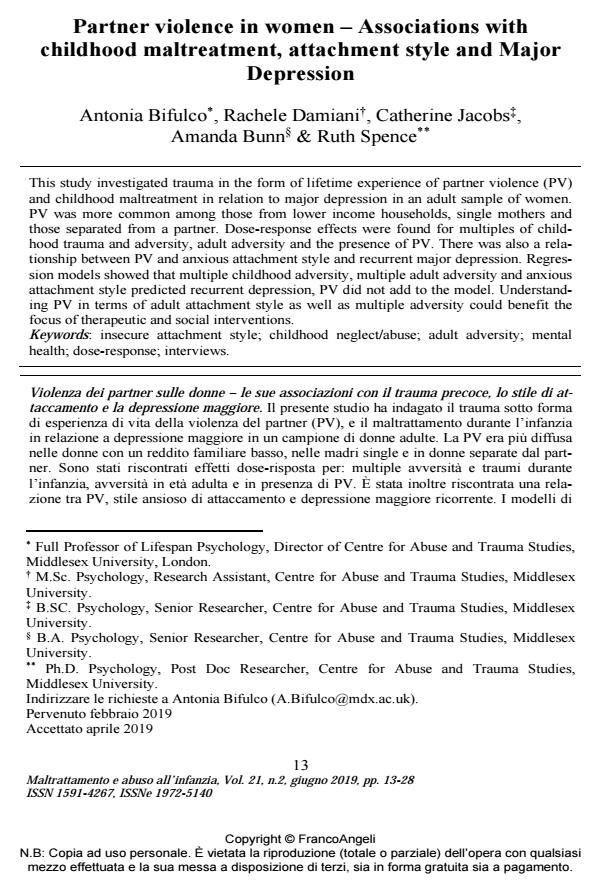Partner violence in women - Associations with childhood maltreatment, attachment style and Major Depression
Titolo Rivista MALTRATTAMENTO E ABUSO ALL’INFANZIA
Autori/Curatori Antonia Bifulco, Rachele Damiani, Catherine Jacobs, Amanda Bunn, Ruth Spence
Anno di pubblicazione 2019 Fascicolo 2019/2
Lingua Inglese Numero pagine 16 P. 13-28 Dimensione file 222 KB
DOI 10.3280/MAL2019-002002
Il DOI è il codice a barre della proprietà intellettuale: per saperne di più
clicca qui
Qui sotto puoi vedere in anteprima la prima pagina di questo articolo.
Se questo articolo ti interessa, lo puoi acquistare (e scaricare in formato pdf) seguendo le facili indicazioni per acquistare il download credit. Acquista Download Credits per scaricare questo Articolo in formato PDF

FrancoAngeli è membro della Publishers International Linking Association, Inc (PILA)associazione indipendente e non profit per facilitare (attraverso i servizi tecnologici implementati da CrossRef.org) l’accesso degli studiosi ai contenuti digitali nelle pubblicazioni professionali e scientifiche
This study investigated trauma in the form of lifetime experience of partner violence (PV) and childhood maltreatment in relation to major depression in an adult sample of women. PV was more common among those from lower income households, single mothers and those sepa-rated from a partner. Dose-response effects were found for multiples of childhood trauma and adversity, adult adversity and the presence of PV. There was also a relationship between PV and anxious attachment style and recurrent major depression. Regression models showed that multiple childhood adversity, multiple adult adversity and anxious attachment style pre-dicted recurrent depression, PV did not add to the model. Understanding PV in terms of adult attachment style as well as multiple adversity could benefit the focus of therapeutic and social interventions.
Violenza dei partner sulle donne - le sue associazioni con il trauma precoce, lo stile di at-taccamento e la depressione maggiore. Il presente studio ha indagato il trauma sotto forma di esperienza di vita della violenza del partner (PV), e il maltrattamento durante l’infanzia in re-lazione a depressione maggiore in un campione di donne adulte. La PV era più diffusa nelle donne con un reddito familiare basso, nelle madri single e in donne separate dal partner. Sono stati riscontrati effetti dose-risposta per: multiple avversità e traumi durante l’infanzia, avver-sità in età adulta e in presenza di PV. È stata inoltre riscontrata una relazione tra PV, stile an-sioso di attaccamento e depressione maggiore ricorrente. I modelli di regressione hanno mostrato che molteplici avversità nell’infanzia, avversità multiple nell’adulto e stile di attaccamento ansiosi predicevano depressione ricorrente, mentre la PV non è risultata aggiungere varianza al modello. Indagare la violenza da parte del partner in termini di stile di attaccamento così come di avversità multiple, potrebbe migliorare il focus degli interventi tera-peutici e sociali.
Parole chiave:Stile di attaccamento insicuro; trascuratezza/abuso infantile; avversità adulte; salute mentale; dose-risposta; interviste.
- Historical child abuse and intergenerational transmission: Experiences of midlife women and their older-age mothers Antonia Bifulco, Catherine Jacobs, Elena Carraro, in MALTRATTAMENTO E ABUSO ALL'INFANZIA 3/2019 pp.23
DOI: 10.3280/MAL2019-003003 - Attachment, Trauma, and Mentalization in Intimate Partner Violence: A Preliminary Investigation Valeria Condino, Guido Giovanardi, Monia Vagni, Vittorio Lingiardi, Daniela Pajardi, Antonello Colli, in Journal of Interpersonal Violence /2022 pp.NP9249
DOI: 10.1177/0886260520980383
Antonia Bifulco, Rachele Damiani, Catherine Jacobs, Amanda Bunn, Ruth Spence, Partner violence in women - Associations with childhood maltreatment, attachment style and Major Depression in "MALTRATTAMENTO E ABUSO ALL’INFANZIA" 2/2019, pp 13-28, DOI: 10.3280/MAL2019-002002